A bad guitar cable can stop working mid-gig and embarrass you. It’s, therefore, important to know the signs of a bad guitar cable so you can either fix the issue as promptly as possible or replace your instrument altogether. That way, you’ll be able to play your guitar with absolute peace of mind and without having to fear any accidental interruptions.
You can tell your guitar cable is bad when it becomes defective and starts to work intermittently while providing a quieter sound. The cable will also buzz and crackle as you move its cord on top of having a thin body and brittle sheathing.
Read on to learn more about the different ways you can tell whether you have a bad guitar cable that is faulty or of poor quality. Moreover, you’ll get to learn more about what constitutes a good cable, as well as some of the high–quality cables you can buy for home use as well as live gigs.
👇😀👇NOTE👇😀👇
If you want to find out what my recommended guitar gear is, then here is what I recommend on Amazon:
- Fender Cutaway Acoustic-Electric Guitar Bundle (MY FAVORITE GUITAR)
- Snark SN-8 Super Tight All Instrument Tuner (Easiest Tuner I’ve Used😏)
- 6 String Acoustic Guitar Capo (Best CAPO for quick changes)
- Dunlop Max Grip 1.0mm Nylon Picks (Thick Guitar Pick So You Don’t Lose Grip!)
- Universal Guitar Stand (Cheap & Minimalist Guitar Stand I Recommend)
- Levy’s 2″ Wide Quick Adjust Guitar Strap (Best Guitar Strap For Any Level)
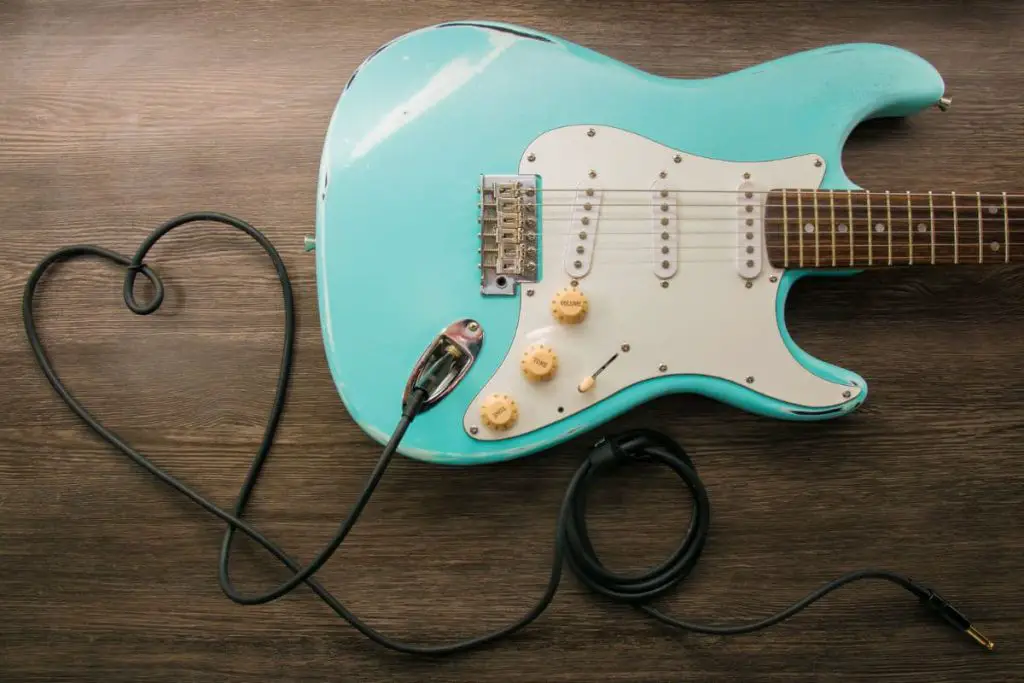
1. Look Out for These Signs
There are many telling signs of a lousy guitar cable that can help you fix the cable before it dies or prevent you from buying the wrong cord. Here are some of the most common:
It Causes Crackling or Hissing and Humming Sounds
If the connectors are faulty, you’ll hear a crackling or hissing sound when the cable is moved around while you touch its ends.
The cable being bad can also cause the guitar to hum because its ground wire is damaged. Noise interference from the environment can bring it on too.
The Guitar Tone Sounds Weak
When the cable or its ground wire is faulty, the sound will not come out as expected. This is because the cord will fail to properly transmit all the signals to the amplifier.
Another cause of the tone not sounding right can be the length of the cable. Longer wires above 20 feet (6.1 meters) can make the sound travel far, making it susceptible to noise pickup, such as radio frequencies from the surrounding area.
The Sound Keeps Cutting In and Out
Sometimes the cable will work intermittently, disrupting the flow of play. To resolve this issue, you should replace the faulty connector or buy a new guitar cable.
Additionally, the problem could be caused by faulty audio jacks that are loose and need tightening or have dirt in them.
Receive No Sound When You Plug It In
When you connect the cable to the amp and hear no sound coming from it, it’s safe to assume that the cable is faulty. However, the problem could also be with the amplifier, so keep that in mind before proceeding any further.
In this case, you should switch cables, and if you receive a sound, the old cord is faulty. However, if the new cable also fails to transmit a signal, then you should have your amp looked at.
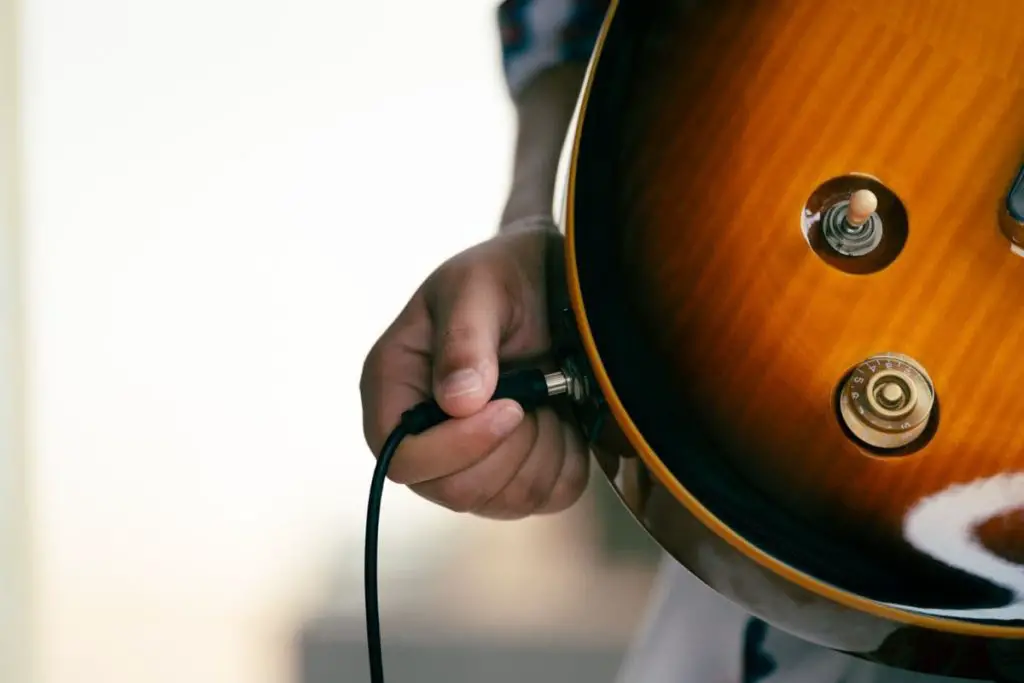
The Cable Electrocutes You When You Touch It
If the cable has exposed wires due to worn-out rubber shielding, electricity can shock you because it is no longer insulated. The zap from a bad guitar cable may not do you much harm, but the experience can be unpleasant.
You can use electrical tape to cover the area if it is not extremely exposed, and you have to use the cable right away. Later on, you should cut the cord at that spot and add a new connector there.
However, if it cannot be repaired because the conductor wires are cut, you should replace the cable.
Picks Up Noise From the Environment
Unlike microphone cables, guitar cables lack features that cancel noise because they are unbalanced. This makes them susceptible to picking up electromagnetic or EM fields and radio frequencies that can interfere with the guitar sound.
You can prevent this from happening by choosing cables with a strong and excellent shield. I highly recommend options with a braided shield.
The Cable Jack Is Loose, or Its Nose Is Bent
A loose jack can prevent the sound signal from smoothly reaching the amp and, in turn, weakens your guitar tone. All you have to do is tighten its nut with a socket wrench, and it can start working well again. However, if you cannot fix the looseness because the jack is completely stripped out, then you should try a loose jack tightener or discard it when it fails to work.
On the other hand, a bent jack nose will also stop the cable from fitting snugly and affect the signal transfer. To straighten the nose, this is what you should do:
- Use a small long nose plier to gently bend the plug back in place to avoid further damaging it.
- Place it against a ruler to check if it is perfectly straight. If not, continue to apply force on it until you get it right.
However, if the plug is overbent, you can either take the cable to a professional to replace it or do it yourself if you know how to in the following steps:
- Buy a 1/4 inch (6.35 mm) new cable jack, preferably a Switchcraft or Neutrik.
- Cut off the damaged plug using plies or a side cutter.
- Use a utility knife to cut a small part of the shield off.
- Separate the wires into three parts and twist the outer two together.
- Remove the outer covering of the middle conductor while taking care not to cut the inside wires, and after, twist the braid.
- Use a soldering iron to tin or heat the two wires and the jack terminals.
- Put the outer cover of the plug onto the lead cable.
- Burn the conductor onto the terminal that connects to the tip of the plug and the other wires to the shield terminal.
- Clap the backend of the plug onto the cable and place the outer cover on the plug before screwing on the solder joint.
- Use a multimeter to test the cable and ensure that it works.
The Cable Stops Working
This can either happen earlier than expected after you have experienced some of the above signs or abruptly without any prior warning of it having a problem.
To prevent this issue from occurring, you should buy good cables from reputable brands or those recommended by other buyers and enthusiasts. This misfortune may take place during your performance, disrupting it, not to mention putting you in an awkward situation where people doubt your professionalism.
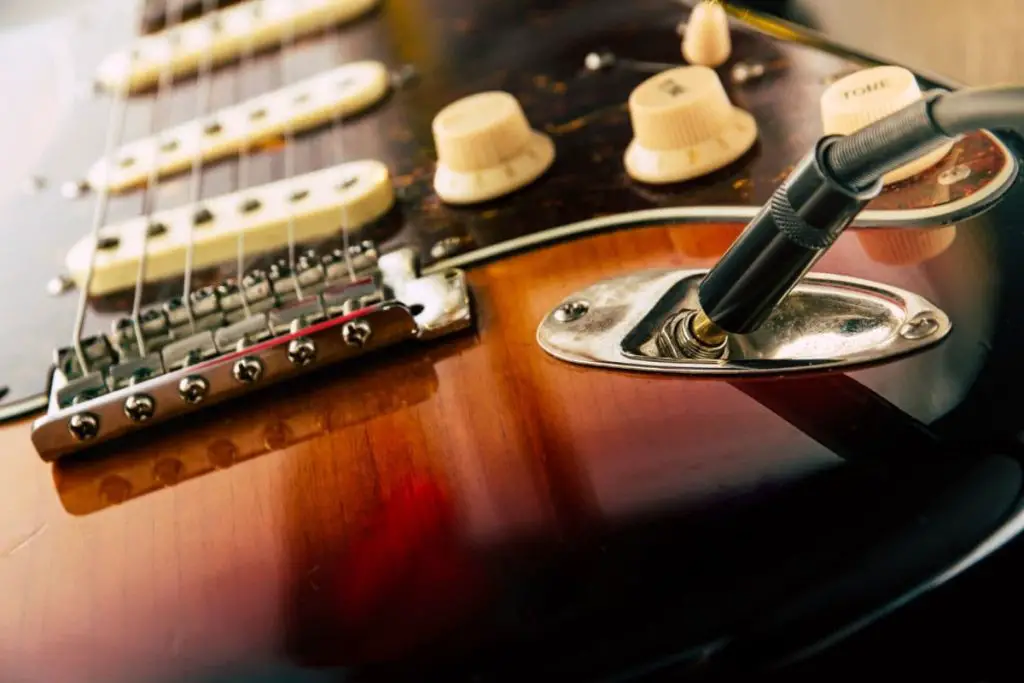
The Cord Has a Thin and Brittle Sheathing
Most cables that have a bad shield are cheap. Therefore, when choosing a cord for your guitar, always critically check out its covering. Besides its weak and stiff sheath, the cable can also have cheap rubber ends.
These kinds of cables can easily get damaged as the brittle shield can break when bent or stepped on, while the inexpensive ends can wear out quickly. Besides, poor shielding can make the cable pick up noise from a location that can interfere with your guitar tone.
Therefore, it’s better to invest in high-quality cables because they can last longer, actually saving you money in the long run.
2. Do the Wiggle Test
This test can help you identify if there is a loose connection in the plug that is causing poor sound signal or cutouts. Connect the cable like you always do when you want to play the guitar and afterward, wiggle the wire and plug.
If there’s a buzzing or hissing sound, your guitar cable is bad. However, if you don’t hear anything, then they’re okay.
Moreover, if you get a humming or popping noise but no signal from the guitar, this means that your instrument is the one experiencing the problem.
3. Change Cables
Swap cables when you hear a popping sound from the input jack as you move the guitar cable up and down. If the problem persists, your jack is the issue, or you have a loose solder joint.
To fix it, you need to remove the jack, tighten its nut and clean the dirt inside before testing it. If you still hear the pop, you should move each wire connected to it and determine which one has an issue to resolder it. After putting everything back together, the cable should work correctly.
However, if you change cables and the problem disappears, it means that the problem lies in a faulty cord.
4. Use an Amp To Test the Cable
To check the signal of the guitar cable and ensure that it’s working correctly, you can use an amp to test it in the following ways:
- Turn the amp on low and place one side of the connector into it.
- Touch your finger to the tip of the other plug and rotate the cable.
- The cable is bad if you hear a popping or scratching sound, which cuts in and out. The reason for this problem is the conductor and ground wire touching the cable or the connectors. You will therefore have to replace this cable.
- Alternatively, if you touch the connector tip and you hear a humming sound, it means there is a connection issue with the cable caused by a bad ground wire.
- However, if you get a solid sound, the cable is in good working condition.
What To Consider When Shopping for a Good Guitar Cable
The Capacitance of the Cable
This can affect the tone of your guitar, and it’s determined by the length of a cable. For low capacitance, which most guitarists prefer, you should get a cable that is 20 feet (6.1 meters) long or shorter.
Low capacitance can add gain and brightness to the sound (if that’s what you need). In contrast, a high capacitance from a long or cheap cable can reduce treble in your tone.
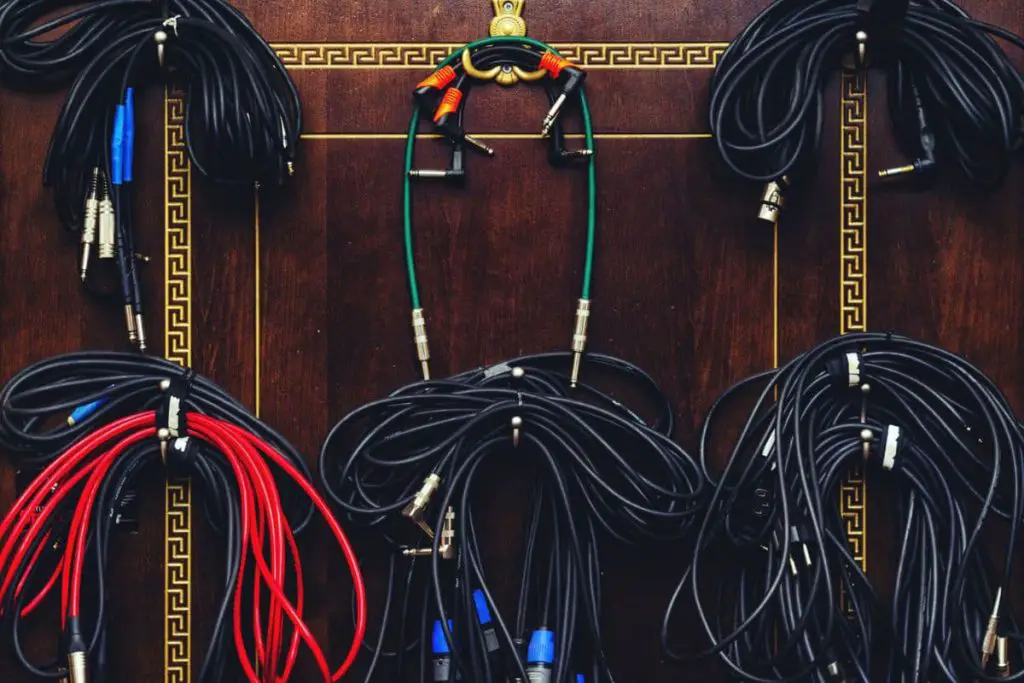
Cable Impedance
A standard guitar cable should have a high impedance as this helps it to control the electric flow in a circuit and prevent it from sparking or frying. To buy a cable with a suitable impedance, you need to match its ohms to that of your electric system (since it is measured in ohms).
Otherwise, if they are dissimilar, the cable may fail to correctly transfer the signal to the guitar. Moreover, the cord should have a good insulation material that’s thick enough, as this also affects impedance.
Quality of Shielding
Avoid cables with plastic, foil, and spiral shielding as these will tend to pick up radio frequencies or EM interference and noise. On top of that, they can easily break when stepped on or over bent/bent frequently.
Instead, buy braided cables because they are more durable and hard to damage. They also have a much more attractive look. These cables can also help provide a clear and high tone.
Durability Levels of Plugs
Buy guitar cables with high-quality plugs, such as those produced by Neutrik or Switchcraft, since they’re solid and long-lasting. The connectors should also have excellent strain relief because most issues occur there.
Bad plugs can fail to transfer the signal and cause the cable to work intermittently or to stop working altogether.
Whetherthe Connectors Can Be Removed and Repaired
Frequently, when you’re having problems with your guitar cable, it’s usually the connectors that have an issue. So, if the cable plugs can be assessed, it means that you can replace or repair them once they get spoilt.
It’s easier and cheaper to repair plugs than to buy new ones whenever they stop working. The only solution that can beat this one is if the cable company provides a lifetime guarantee and you can replace the faulty one anytime. But even then, you may not always have the time to trade in the bad one, especially in cases where the cable fails to work right before you start your gig.
Whether It Has a Lifetime Warranty
With this assurance, you can get a free new cable whenever the one you have stops working correctly. You can, therefore, end up saving valuable money.
That said, you can tell that a company offers high-quality cables once it offers this type of guarantee, as it would be making losses if it did not. You will rarely have to take back your cables since they are made of premium materials and highly durable.
High-Quality Cables To Buy
These cables might cost more initially, but will save you money in the long run, as they can work for a long time without getting damaged.
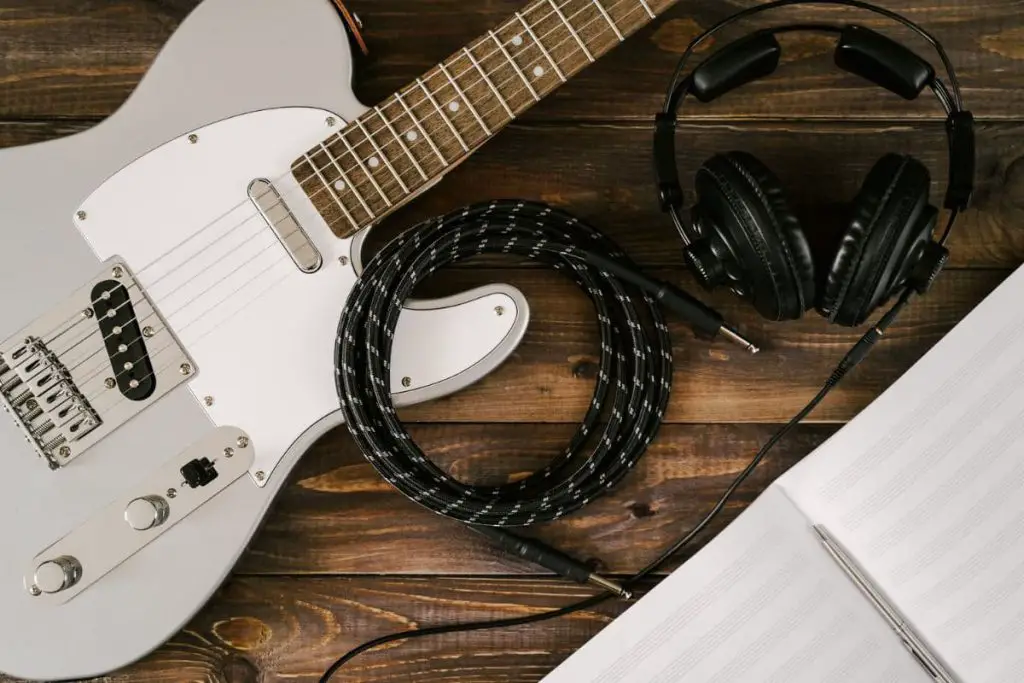
Additionally, you’ll avoid noise interference from poor-quality cables that distort tone. Here are the four best guitar cables you can buy from Amazon.com:
Tangle Free Braided Ernie Ball Cable
The braided jacket of this cable helps it to stay tangle free and prevents people from tripping on it and pulling it out of the circuit while you play your guitar. You will also avoid electric shocks and short circuits resulting from cables tangling. Besides that, its multiple shielding makes it durable and less likely to pick up noise from the environment that can affect your tone.
If that weren’t enough, the Ernie Ball cable comes in a wide array of bright colors, such as neon, yellow, orange, and pink, making it easily visible in low-lit gig areas so that people cannot stumble on it.
Lifetime Warranty Fender Professional Series Instrument Cable
You can use this cable at home and on the road without any distortion to your guitar’s sound because it comes equipped with spiral shielding that prevents noise interference. The guarantee ensures that you can always get a free replacement whenever the cable you’re using gets damaged.
Moreover, these cables come in different lengths, and their design prevents twisting and kinking, which enables them to last longer since they cannot easily break.
Highly Durable Kirlin Cable
This premium cable has a woven fabric shield that protects it against damage from people stepping on it or liquids getting spilled. It also provides a top-notch sound as it has good signal strength, looks good, and is affordable.
Besides that, it does not twist or tangle up and has a lifetime guarantee that you can make use of anytime.
Secure Connection D’Addario Planet Wavex Cable
Its GeoTip plug design provides a snug fit and solid connection that prevents it from popping out and causing signal loss. This cable also delivers a clear, natural tone since it’s made with a quality audiophile wire.
Moreover, its smooth sheath makes it durable and rejects any noise interference that can disrupt sound.
Conclusion
A faulty guitar cable can mess up the tone of your instrument. To best prevent this issue from causing too much trouble, you need to be aware of some of the tell-tale signs that warn you when there’s anything wrong with your cable. That way, you’ll be able to act quickly and remedy any issues that might otherwise ruin a future performance.
It’s always best to invest in high-quality cables. You might have to shell out a bit more, but you’ll use the cord for a long time without facing any frustrating problems like humming, cracking, or noise interference.
👇😀👇NOTE👇😀👇
If you want to find out what my recommended guitar gear is, then here is what I recommend on Amazon:
- Fender Cutaway Acoustic-Electric Guitar Bundle (MY FAVORITE GUITAR)
- Snark SN-8 Super Tight All Instrument Tuner (Easiest Tuner I’ve Used😏)
- 6 String Acoustic Guitar Capo (Best CAPO for quick changes)
- Dunlop Max Grip 1.0mm Nylon Picks (Thick Guitar Pick So You Don’t Lose Grip!)
- Universal Guitar Stand (Cheap & Minimalist Guitar Stand I Recommend)
- Levy’s 2″ Wide Quick Adjust Guitar Strap (Best Guitar Strap For Any Level)

